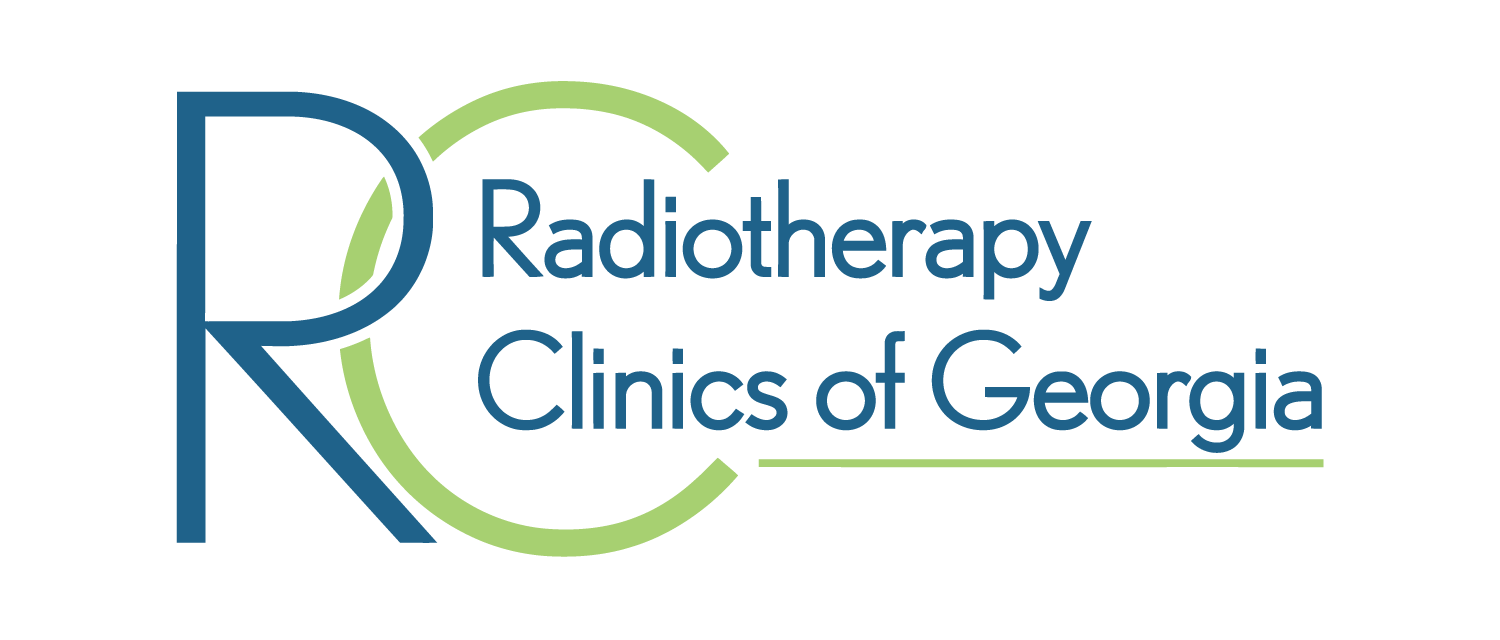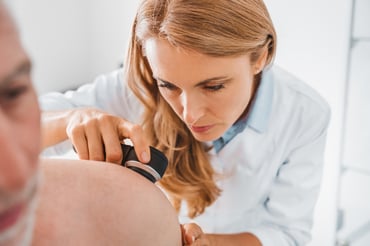
Skin cancer occurs when changes develop in the DNA of your skin cells. This causes the cells to grow out of control, forming a skin “lesion.” This can be a bump, a mole that becomes abnormal or a sore that won’t heal. The most common types of skin cancer are squamous cell carcinoma, basal cell carcinoma, and melanoma.
Skin cancer develops in the top layer of skin (epidermis), beginning in one of the three layers of epidermal cells:
- Squamous cells are immediately below the outer skin surface and act as a skin lining.
- Basal cells grow just below squamous cells and produce new skin cells.
- Melanocytes, in the lower part of the skin, produce skin pigment.
Basal cell and squamous cell carcinomas usually develop in areas that receive a lot of sun exposure, such as your face, neck, ears, or hands. Melanoma can occur anywhere but often develops from an existing mole.
How is Skin Cancer Diagnosed?
Diagnosis begins when a doctor – such as your primary care doctor or a dermatologist– identifies an area on the skin that looks suspicious. The doctor may remove the whole thing if it’s small enough and on the surface. A sample of this will be sent for testing. If the area is too large or too deep to be removed in the office, a biopsy may be done that removes a sample of skin for laboratory testing. The results of the biopsy will indicate if skin cancer is present and tell you what type of skin cancer it is.
If you have melanoma, the cancer will be staged to determine how much cancer is present. Stage I is limited to the area where it first appeared, ranging up to stage IV, indicating that it’s spread to other parts of your body. If the cancer is large, your lymph node(s) may be removed to find out if the cancer has spread.
Basal cell and squamous cell carcinomas are not staged because they are so often curable and rarely spread.
What are My Treatment Options?
Treatment depends on the type of cancer, its stage, size, location, and skin depth. The most common treatment options are:
- Removal of a small cancer on the skin’s surface, usually in the doctor’s office with no additional treatment.
- Freezing which causes it to slough off shortly after treatment.
- A more formal surgery that cuts out the cancer plus a small margin of healthy skin.
- Mohs surgery removes the cancer layer-by-layer until no abnormal cells remain, preserving as much healthy skin as possible. It’s used on larger, hard-to-treat, or recurrent cancers.
- Radiation therapy uses high-energy beams to kill skin cancer cells.
- Chemotherapy is used topically or internally to treat cancers that have spread.
- Photodynamic therapy uses lasers and drugs.
- Biological therapy boosts your own immune system to kill cancer cells.
When is Radiation Therapy Needed for Skin Cancer?
Not every skin cancer patient is not a candidate for radiation therapy. However, a cancer specialist may feel that treatment with external beam radiation therapy (EBRT) will ensure that the cancer cells in the original area are all killed. EBRT is the most common type of radiation for skin cancers. It’s painless and doesn’t penetrate deeper than the skin, which helps limit side effects and keeps treatment times short.
Radiation therapy may be used effectively in these situations:
- Cure small basal or squamous cell skin cancers
- Stop the growth of advanced skin cancer or cancers that have spread
- Treat large cancers or cancers that are hard to surgically remove
- After surgery, to kill any cancer cells that couldn’t be removed surgically
- Delay the growth of more advanced cancers
- Lower the risk of recurrent cancer
- Treat patients who cannot have surgery
Will I Have Radiation Therapy Side Effects?
When radiation therapy kills skin cancer cells, it can also damage healthy tissue around the cancer. Damage to healthy tissue can cause side effects.
The most common side effect for skin cancer treatment is skin irritation in the treatment area. This can feel a lot like a sunburn with redness and peeling skin. When treatment is over this will usually go away. There are other side effects that you could experience such as:
- Fatigue
- Hair loss in the treatment area
- Damage to saliva-producing glands or teeth
Additional side effects can occur, depending on the area that’s being treated. If the skin over the chest area is treated, you may have, in addition to the problems listed above, trouble swallowing, cough, or shortness of breath. Breasts can be tender to the touch and swollen (edema).
Treatment targeting the head may also cause memory problems, trouble concentrating, nausea and vomiting, headache, changes in taste, a less active thyroid gland, or blurry vision.
Treatment over the stomach, pelvic, or rectal areas can also cause diarrhea, nausea, vomiting, fertility problems, or bladder problems.
After treatment, these side effects will lessen, and most patients will recover within a few months.
Talk with your healthcare team regularly about how you are feeling. They need to know about any new side effects or changes in existing side effects in order to help you manage them.
Pay Attention to Skin Care
Taking proper care of your skin will help reduce pain and help your skin recover more quickly.
Begin these care tips on the day you start radiation treatments, continuing until radiation is over:
- Wash skin in the treatment area very gently, using only your hands to splash warm water on your skin. A sponge or washcloth will irritate skin, setting you up for an infection.
- To clean the skin, use a gentle, low-pH cleanser applied with your hands, rinsing with warm water.
- Don’t shave the area.
- Apply moisturizer according to your care team’s instructions, using the moisturizer they recommend. Never apply it to a wound.
- Follow instructions on wound care to avoid infection and promote healing.
- Don’t use antiperspirant or talcum powder – they can increase the amount of radiation you receive.
- Don’t use anything sticky near the area, such as band-aids or nicotine patches.
- Avoid products containing a fragrance including laundry soap, body soap and perfumes.
- Wear loose-fitting clothes.
- Protect your skin from the sun; only use the recommended sunscreen.
- Avoid tanning beds or sun lamps. This is a good rule of thumb in general to help avoid more skin cancer from developing
- Protect skin from heat and cold, including a heating pad or ice pack.
- Don’t use a hot tub.
Coping Strategies During Radiation Therapy
Your skin cancer care team can also help with the emotional aspects of skin cancer diagnosis and treatment, such as depression, anxiety, stress, or fear. Called palliative or supportive care, it’s an important part of your treatment plan. It’s just as important to your full recovery as the physical side. Strategies include:
- Talk with an oncology social worker or your spiritual counselor about ways to cope with your diagnosis and treatment. Expressing strong emotions like fear or anxiety can help you let go of these feelings.
- Learn to take in the present moment instead of dwelling on an unknowable future or a difficult past.
- Practice feeling peaceful, even for a short time every day. This skill can help you to return to a peaceful attitude when life becomes stressful.
- Focus on your strengths and wellness.
- Do things you enjoy to help yourself relax.
- Ask yourself what you can do right now to stay healthy whenever you feel overwhelmed..
- Ask about local support groups of people who are also cancer survivors. Patients who attend support groups have an improved quality of life, better sleep, and appetite. Contact the American Cancer Society about support groups and other coping resources.
What is the Process for External Beam Radiation Therapy?
Preparing for radiation therapy starts with developing a treatment plan designed for your specific needs. Your radiation oncologist will review your medical history, examine you, and may recommend further testing. You’ll also discuss the potential risks and benefits of treatment options.
Once you and your doctor agree that radiation is your best treatment option, you’ll sign an "informed consent" form to proceed with treatment.
The first treatment session is a simulation of exactly what will occur when radiation starts. Your treatment team will use imaging scans to confirm the cancer’s location, and they may mark this location on your skin. Depending on the treatment area, you may have an immobilization device (tape, headrests, or molds) to keep you in the same position for each treatment session.
Treatment sessions last about 15-30 minutes each and are painless. You will hear clicking or buzzing and the machine may move to change the angle that it delivers radiation. Most patients have treatment five days per week for three to nine weeks.
What Care Will I Need After Treatment?
After-treatment care begins with you. Continue to monitor your skin regularly to check for changes or rashes, and report them to your doctor, even if they seem minor.
You’ll need follow-up visits every six to 12 months after your treatment ends. This is important to prevent complications or recurrent cancers and monitor your treatment’s effectiveness. If you had melanoma, your risk of it returning or developing a second melanoma is very high. Your doctor may recommend additional lab or imaging tests to look for signs of cancer returning or to monitor the side effects of treatment.
Follow-up visits are the best time to discuss any problems you’re having with side effects. Even if you feel like you’re cured, never skip a follow-up appointment. You should also continue to have regular screening tests for all types of cancers. Ask your care team for a list of changes you should watch for.
Be vigilant about skin cancer prevention by limiting sun exposure, avoiding smoking and alcohol, and maintaining a healthy weight with a diet rich in fruits, vegetables, and whole grains. Get some physical activity every day.
Radiation Oncologists Treating Skin Cancer in the Greater Atlanta Area
Skin cancer patients in the Atlanta area can receive skin cancer treatment close to home with the latest in external beam radiation therapy. Our cancer treatment centers are located in Conyers, Covington, Decatur, and Snellville, Georgia. Request an appointment at a location that’s convenient for you.


